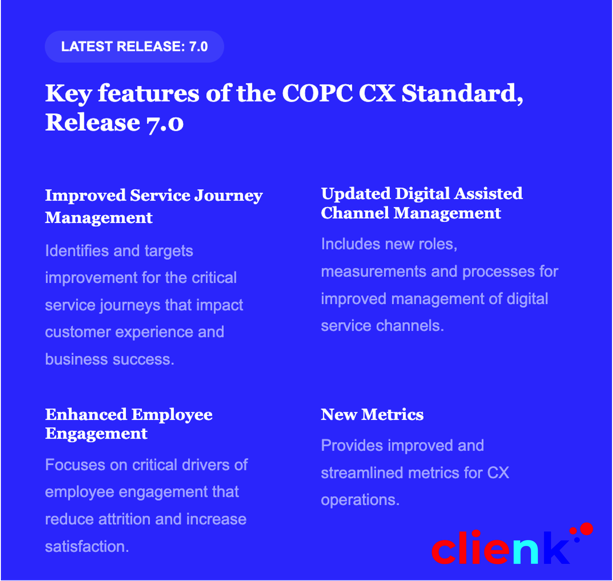Understanding the COPC CX Standard Release 7.0
In the world of customer experience management, performance management systems are crucial. They help organizations save time and money by identifying performance and process issues and taking corrective actions that produce tangible CX improvements. One such performance management system is the COPC CX Standard, which has been used by major brands throughout the world to manage and improve their CX management programs. The latest version of the COPC CX Standard is Release 7.0, which has been developed to address the changing landscape of CX operations.
What is the COPC CX Standard?
The COPC CX Standard is a performance management system for CX operations, including contact centers, unassisted transactions, face-to-face environments, and field service dispatch. It is a proprietary CX framework that is co-developed and maintained by some of the world’s largest brands. The COPC CX Standard was established in 1996 by a group of industry leaders from companies such as Microsoft, Dell, American Express, Motorola, Adobe, and Intel.
The COPC Standards Committee oversees the evolution of the COPC CX Standard. Its purpose is to establish guidelines, best practices, metrics, and performance requirements that buyers of outsourced services should expect of their customer contact suppliers. The COPC CX Standard has a rich and important history spanning over 25 years. COPC Inc. founders identified a gap in the industry and brought global industry leaders together to establish the Standard.
What’s New in Release 7.0?
The COPC CX Standard Release 7.0 has been developed to address the changing landscape of CX operations. It reflects the industry’s latest trends and emerging technologies that impact CX operations. Here are some of the updates to the Standard:
The Gig Economy and Its Impact on CX
The growing reliance on the gig workforce, primarily for a select set of digital transactions, has implications for contact centers from a staffing, process, and legislative perspective. The COPC Standards Committee is monitoring the gig economy and evaluating potential adjustments that may need to be made to the COPC CX Standard when appropriate.
Implications of the Permanent Shift to Work-At-Home (WAH) and Hybrid Working Models
Given the more permanent shift to WAH or hybrid working models, many organizations realize that some of the processes and approaches that work for “brick and mortar” are not always transferable to a WAH environment. Quality monitoring and business continuity requirements are a couple of examples. The COPC Standards Committee is reviewing the Standard and adjusting it to reflect the maturity of key customer-related and support processes providing proven best practices for these models.
Evolving Workforce Management (WFM) Strategies
Vendor management organizations (VMOs) and their shared services are increasingly taking on WFM roles and functions to effectively manage transaction volumes across their (often multi-vendor) enterprise. As this happens, metrics used to evaluate the effectiveness of a service provider’s WFM function are incomplete. The COPC Standards Committee is assessing new metrics that reflect the adoption of additional WFM functions by VMOs to ensure accountability and measure the effectiveness of both the VMOs and the outsource service providers (OSPs).
Impact of Emerging Technology on CX Operations
The advancement of technology supporting data security and privacy (particularly for WAH) and artificial intelligence (AI) advancements in training and transaction handling are some of the updates to the COPC CX Standard Release 7.0. The COPC Standards Committee continues to monitor potential necessary changes related to technology advancements and their impact on CX operations.
Successful Employee Engagement Strategies
Many organizations are focused on employee engagement to improve retention, overall well-being, and the customer experience. Finding new ways to keep employees engaged is becoming increasingly challenging. The COPC Standards Committee discussed the importance of measuring engagement throughout the employee lifecycle and the appropriate metrics that can enable continuous improvement.
How Does Clienk Adhere to the COPC CX Standard?
Clienk Insights and Reporting Module adheres to the COPC CX Standard version 7.0. Clienk is a real-time reporting platform that helps customer experience teams make data-driven decisions. It provides insights into the customer journey and helps teams understand how customers interact with their brand. Clienk enables teams to monitor key metrics such as first call resolution, average handle time, customer satisfaction, and more.
The Clienk Insights and Reporting Module is designed to help organizations save time and money by identifying performance and process issues and taking corrective actions that produce tangible CX improvements. It is an intuitive platform that enables teams to adopt and implement proven best practices to facilitate significant and sustained performance. The Clienk Insights and Reporting Module ensures that best practices are implemented that drive meaningful results and focuses on the areas that have the greatest impact.

